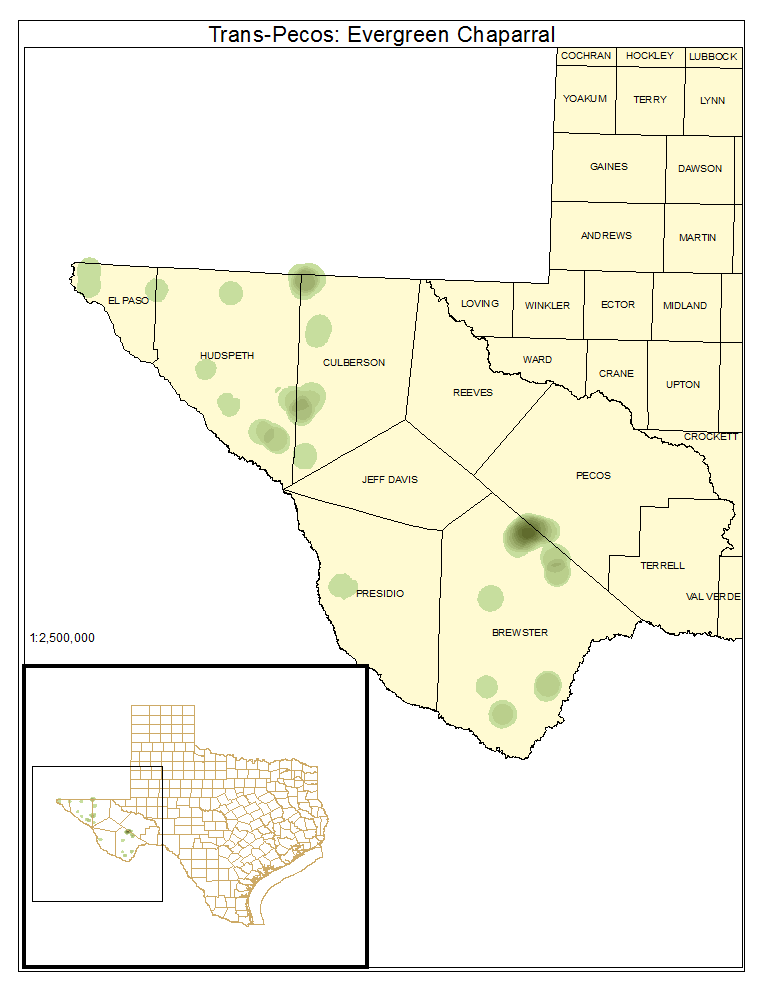Madrean Oriental Chaparral
Geology
Various formations at higher elevations of the mountains of West Texas, including the Permian limestones of the Guadalupe Mountain region, Tertiary igneous formations, and sedimentary formations including limestone and sandstone elsewhere.
Landform
Montane slopes.
Soils
Rocky and gravelly slopes, often with little soil development.
Parent Description
This system occurs at elevations above desert shrublands on dry rocky habitats of foothills, mountains, and canyons. It often occurs at elevations coincident with the occurrence of Madrean Encinal and Madrean coniferous woodlands, but typically occupies more xeric sites, often with steeper slopes and less soil development. Shrub cover is typically moderate to dense. Oak species such as Quercus grisea (gray oak), Quercus vaseyana (Vasey shin oak), Quercus pungens (sandpaper oak), Quercus x pauciloba (wavyleaf oak), Quercus turbinella (scrub oak), Quercus mohriana (Mohr's shin oak), and Quercus gambelii (Gambel oak) occurring as shrubs may be present to dominant making distinguishing this system from Madrean Encinal sometimes difficult. Other shrub species that are commonly encountered to dominant, include Cercocarpus montanus (mountain mahogany), Pinus cembroides (Mexican pinyon pine) or Pinus edulis (pinyon pine, in the Guadalupe Mountain region), Ceanothus greggii (desert ceanothus), Fallugia paradoxa (Apache plume), Rhus virens (evergreen sumac), Garrya wrightii (Wright's silktassel), Aloysia wrightii (Wright's beebrush), Juniperus pinchotii (redberry juniper), Chrysactinia mexicana (damianita), Fraxinus greggii (little-leaf ash), and Viguiera stenoloba (skeleton-leaf golden eye). Dasylirion leiophyllum (smooth sotol), Nolina texana (Texas sacahuista), Agave lechuguilla (lechuguilla), and Opuntia engelmannii var. engelmannii (Engelmann pricklypear) are frequently encountered. Herbaceous cover is patchy and bare rock is frequently visible. Graminoids dominate the herbaceous layer with species such as Bouteloua curtipendula (sideoats grama), Bouteloua hirsuta (hairy grama), Muhlenbergia emersleyi (bull muhly), Muhlenbergia pauciflora (New Mexican muhly), Muhlenbergia setifolia (curlyleaf muhly), Achnatherum lobatum (littleawn needlegrass), Muhlenbergia dubia (pine muhly), and Heteropogon contortus (tanglehead).
Ecological Mapping Systems
Trans-Pecos: Evergreen Chaparral
Shrublands dominated by evergreen species that may include Quercus mohriana (Mohr's shin oak), Quercus pungens (sandpaper oak), Quercus vaseyana (Vasey shin oak), Quercus turbinella (scrub oak), and Rhus virens (evergreen sumac).
Distribution Map

Photos

Trans-Pecos: Deciduous Chaparral
Shrublands dominated by deciduous species.
Distribution Map

Photos

Public Land Occurrence
- Big Bend National Park: US National Park Service
- Davis Mountains State Park: Texas Parks & Wildlife Department
- Elephant Mountain Wildlife Management Area: Texas Parks & Wildlife Department
- Fort Davis National Historic Site: US National Park Service
- Guadalupe River State Park: Texas Parks & Wildlife Department
- Sierra Diablo Wildlife Management Area: Texas Parks & Wildlife Department